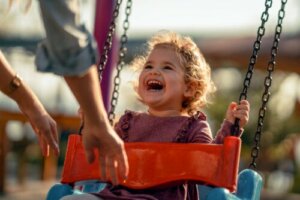The Influence of the Family Environment on Children

When parents think about their children’s education, they tend to focus on very specific aspects: Setting limits, stimulating creativity, or enhancing their abilities. And although all these aspects are very relevant, we can’t lose sight of the fact that simply being part of a family affects the development of children’s personalities. Indeed, the family environment exerts a constant influence that, although sometimes unnoticed, ends up shaping the deepest beliefs of children.
What emotions do you feel when you enter your house? How do the people living together relate to one another? What are the values that guide the family? These questions are decisive and it’s important to analyze if we’re providing our children with the environment we want or if it’s time to make some changes.
What is the family environment?
In general terms, we can say that a positive family environment is one that favors the development and well-being of its members. On the contrary, a negative environment causes anguish, suffering, or limits the good functioning of the family members. However, there’s no single model for each one.
There are homes in which laughter, bustle, and shared time among family and friends prevail. All this can be very positive and stimulating for children.
On the other hand, other families offer a quiet and relaxing environment, where activities such as art or reading predominate and where members are invited to introspection. And in this case, the children may also benefit.
Similarly, it’s not only shouting, hitting, or fighting that make up a negative family environment. Families where there’s silence and indifference among family members can be equally harmful to everyone involved.
If a child grows up in an environment where parents don’t speak to each other or where adults are too busy to spend time with their children, emotional deficiencies will soon appear.
So, what aspects make up the family environment? Here they are:

Interactions between family members
How family members relate to each other is crucial.
How do they talk to each other? How do they treat each other? In what tone and with what words do they talk to each other? Do they spend time together and do they maintain fluid communication and an emotionally close relationship? And we’re not only talking about the relationship between parents and children, but also about couple dynamics and fraternal relationships.
Responsibilities and roles
For a family to function properly, it’s important that roles are well defined and appropriate.
Therefore, parents must exercise authority while considering the opinions, needs, and points of view of their children.
In addition, everyone must collaborate with household chores and have their own responsibilities. If parents are too authoritarian, permissive, or negligent, the atmosphere in the home will worsen drastically.
Moods
There’s no doubt that the mood of each family member contributes to a more or less pleasant home climate.
If parents or children are constantly frustrated, stressed, or dissatisfied, the family atmosphere becomes tense and unpleasant. The opposite happens when the family is used to maintaining a flexible and positive attitude, as this allows all members to experience gratitude and satisfaction with their lives.
Values and priorities
Values are the guidelines that direct the family’s daily behavior and demonstrate its priorities. Those homes in which love, respect, empathy, and tolerance are valued have a more pleasant and harmonious environment.
How does the family environment influence children?

The above aspects are the sources of information that children have access to on a daily basis to build their vision of the world. From every moment spent with their family, they take with them the thoughts, attitudes, and beliefs of those living with them, which they’ll later replicate throughout their life.
But, specifically, the family environment influences the following issues:
- It provides, indirectly, an education in values.
- It allows (or hinders) the development of emotional intelligence, depending on how others manage emotions.
- It prevents behavioral problems in children.
- It offers a space full of opportunities to acquire and improve social skills. By interacting with the family and observing how others relate to each other, the child absorbs this knowledge and practices it.
- It allows the child to begin to build their identity and self-esteem. Based on the words and treatment received within the family, the child forms a more or less positive self-image.
- It influences the child’s mood. It can make them more prone to depression if it’s not adequate.
- It shapes expectations about the world.
Ultimately, a safe and pleasant family environment is the best gift we can offer children. Growing up surrounded by love and laughter, where they can witness respectful relationships between healthy and happy people is the best foundation for their future. Therefore, take care of this environment to which your children are exposed on a daily basis.
When parents think about their children’s education, they tend to focus on very specific aspects: Setting limits, stimulating creativity, or enhancing their abilities. And although all these aspects are very relevant, we can’t lose sight of the fact that simply being part of a family affects the development of children’s personalities. Indeed, the family environment exerts a constant influence that, although sometimes unnoticed, ends up shaping the deepest beliefs of children.
What emotions do you feel when you enter your house? How do the people living together relate to one another? What are the values that guide the family? These questions are decisive and it’s important to analyze if we’re providing our children with the environment we want or if it’s time to make some changes.
What is the family environment?
In general terms, we can say that a positive family environment is one that favors the development and well-being of its members. On the contrary, a negative environment causes anguish, suffering, or limits the good functioning of the family members. However, there’s no single model for each one.
There are homes in which laughter, bustle, and shared time among family and friends prevail. All this can be very positive and stimulating for children.
On the other hand, other families offer a quiet and relaxing environment, where activities such as art or reading predominate and where members are invited to introspection. And in this case, the children may also benefit.
Similarly, it’s not only shouting, hitting, or fighting that make up a negative family environment. Families where there’s silence and indifference among family members can be equally harmful to everyone involved.
If a child grows up in an environment where parents don’t speak to each other or where adults are too busy to spend time with their children, emotional deficiencies will soon appear.
So, what aspects make up the family environment? Here they are:

Interactions between family members
How family members relate to each other is crucial.
How do they talk to each other? How do they treat each other? In what tone and with what words do they talk to each other? Do they spend time together and do they maintain fluid communication and an emotionally close relationship? And we’re not only talking about the relationship between parents and children, but also about couple dynamics and fraternal relationships.
Responsibilities and roles
For a family to function properly, it’s important that roles are well defined and appropriate.
Therefore, parents must exercise authority while considering the opinions, needs, and points of view of their children.
In addition, everyone must collaborate with household chores and have their own responsibilities. If parents are too authoritarian, permissive, or negligent, the atmosphere in the home will worsen drastically.
Moods
There’s no doubt that the mood of each family member contributes to a more or less pleasant home climate.
If parents or children are constantly frustrated, stressed, or dissatisfied, the family atmosphere becomes tense and unpleasant. The opposite happens when the family is used to maintaining a flexible and positive attitude, as this allows all members to experience gratitude and satisfaction with their lives.
Values and priorities
Values are the guidelines that direct the family’s daily behavior and demonstrate its priorities. Those homes in which love, respect, empathy, and tolerance are valued have a more pleasant and harmonious environment.
How does the family environment influence children?

The above aspects are the sources of information that children have access to on a daily basis to build their vision of the world. From every moment spent with their family, they take with them the thoughts, attitudes, and beliefs of those living with them, which they’ll later replicate throughout their life.
But, specifically, the family environment influences the following issues:
- It provides, indirectly, an education in values.
- It allows (or hinders) the development of emotional intelligence, depending on how others manage emotions.
- It prevents behavioral problems in children.
- It offers a space full of opportunities to acquire and improve social skills. By interacting with the family and observing how others relate to each other, the child absorbs this knowledge and practices it.
- It allows the child to begin to build their identity and self-esteem. Based on the words and treatment received within the family, the child forms a more or less positive self-image.
- It influences the child’s mood. It can make them more prone to depression if it’s not adequate.
- It shapes expectations about the world.
Ultimately, a safe and pleasant family environment is the best gift we can offer children. Growing up surrounded by love and laughter, where they can witness respectful relationships between healthy and happy people is the best foundation for their future. Therefore, take care of this environment to which your children are exposed on a daily basis.
All cited sources were thoroughly reviewed by our team to ensure their quality, reliability, currency, and validity. The bibliography of this article was considered reliable and of academic or scientific accuracy.
- Cantón, J., & Cortés, R. (2000). Ambiente familiar y dificultades de adaptación de los hijos. Suma Psicológica, 7(1), 33-49. Disponible en: http://publicaciones.konradlorenz.edu.co/index.php/sumapsi/article/view/205
- Villatoro, J. A., Andrade, P., Fleiz, C., Medina-Mora, M. E., Reyes, I., & Rivera, E. (1997). La relación padres-hijos: una escala para evaluar el ambiente familiar de los adolescentes. Salud mental, 20(2), 21-27. Disponible en: http://www.revistasaludmental.mx/index.php/salud_mental/article/view/647/646
- Salazar, Y., Veytia, M., Márquez, O., & Huitrón, G. (2013). Relación entre satisfacción con el ambiente familiar y depresión en adolescentes. Psicología y salud, 23(1), 141-148. Disponible en: https://psicologiaysalud.uv.mx/index.php/psicysalud/article/view/524
This text is provided for informational purposes only and does not replace consultation with a professional. If in doubt, consult your specialist.








